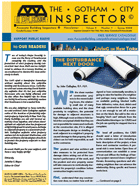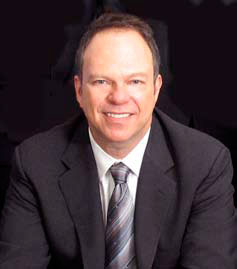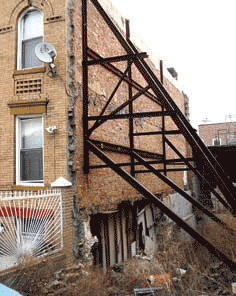- Publications:
- Newsletter:
- How-To Tutorials:
- Consumer Guides:
- Related:

Image by Robert Ubell
Publishers:
Accurate Building Inspectors ©
Division of Ubell Enterprises, Inc.
1860 Bath Avenue
Brooklyn, NY 11214-4616
voice – 718.265.8191
toll free voice – 800.640.8285
fax – 718.449.7190
Lawrence J. Ubell *
- President
Alvin Ubell **
- Founder, Vice President
Matthew Barnett *
- Senior Inspector
Estelle R. Ubell
- Sec. Treasurer
Jennifer S. Bleyer
- Editor-in-Chief
Contributors:
Adam Leitman Bailey, Esq.
Hon. Jules L. Sprodek, (RET)
Robert H. Wolff, Esq. of Rosenberg,
Minc, Falkoff
& Wolff, LLP
Ari Saltz, of GFI Mortgage Bankers, Inc.
Stanley Turkel, MHS, ISHC
Bertrum Herman, Esq.
Howard Kurtzberg, Esq.
Mitchell D. Kessler, Esq.
Sebastian M. D'Alessandro, RA
Terrence E. O'Neal, RA, AIA
David A. Kaminsky, Esq.
John Gallagher, RA AIA
* Licensed in: New York - New Jersey
** Licensed in: NJ
Contribute:
If there is a subject that you would like to see discussed or an article that you would like to contribute to be featured
in The Gotham City Inspector©, please forward your comments to:
Letters to the Editor
Media Notice: The publishers, grant reprint permission of all articles in the Gotham City Inspector© Newsletter, provided that appropriate written recognition is given to the authors and “The Gotham City Inspector©”. For online reprints, please also include an HTML link to The Gotham City Inspector© : www.accuratebuilding.com

The Gotham City Inspector©
Newsletter: Spring 2008, Vol.5, No.1

![]() Gotham City Inspector Newsletter
Gotham City Inspector Newsletter
Summer Headlines:
Living In New York
The Disturbance Next Door

With the sheer number of construction projects in the recent building boom, the relatively small size of many available building sites, and the close proximity to neighbors, the potential for damage to adjacent structures is high. Although most architects hide behind the conceptual shield that they are not responsible for means and methods at the construction site, if it is alleged that inadequate design or detailing of work adjacent to a neighbor's property caused damage to that property, the architect can be held responsible, as well as the contractor.
The prudent and wise architect will take measures to be protected from damage claims arising out of the contractor's performance of the work, and the prudent and wise property owner will take measures to meticulously document his property's condition before construction begins next door.
Potential Problems
First, understand that any construction next door, no matter how well designed or how contextually sensitive, is going to raise the hackles of a neighbor and perhaps many neighbors. Strains on available parking, blocked traffic from deliveries, noise, dust, debris and that ugly construction fence for a year or so are enough to set off a revolution on the block. But add to the mix a haughty “don't care” attitude from the client/builder/developer (or C/B/D) and the job can quickly be stopped due to a complaint.
Notifying the Neighbors
To head off problems, the C/B/D should send a letter of introduction to the residents next door including a basic description of the project, a time frame and contractor numbers. A personal visit is even better. Open lines of communication can establish a sense of trust and diffuse the feelings of having a project rammed down neighbors' throats. Answering questions and alleviating neighbors fear can advance the relationship. Being specific and honest works best.
Benefits of Pre-Construction Inspection
Either the C/B/D or the adjacent property owner should arrange a visit to the neighboring buildings by a licensed building inspector for an in-depth survey and phototropic documentation of the property and home to ascertain existing conditions.
The goal of the inspection is to discover any signs of settlement, cracks in foundations and walls, doors and windows that don't open and close, separation of a chimney from the structure, cracks in the cellar slab, conditions of utility and water/ sewer entry points or signs of water intrusion; in short, anything that might be blamed on the C/B/D after the work begins. Extensive notes and photographs or video with the date and time inscribed should be provided as documentation. Thoroughness is important. A large condo next door might take several visits. Detail is important and rushing through could overlook important points.
A walk around the outside of the house may reveal cracks or recent repairs. Don't forget walkways, retaining walls, driveways, decks, patios and landscaping. Where appropriate, crack monitors are a good investment.
In rare instances, the results of the inspection will point to necessary changes in the design or in the planned construction sequence or method. As the construction work progresses, a reinspection may be in order, especially if crack monitors were used. If damage is found, early intervention can avert a disaster by indicating further changes in the construction process or other protective measures. Steps taken to minimize additional damage tend to quickly rectify any damage done.
The key concept is that by documenting conditions before the work starts, should a claim of damage arises, it might be supported or refuted by the collected information so that a suit does not develop.
Being Neighborly
Another step the C/B/D should initiate to keep peace in the neighborhood is convincing his client to paint the construction fence and keep it in place. A fence that blows down on every windy day poses a nuisance and shows that the C/B/D doesn't care. The fence should be kept free of graffiti and posters, the street swept daily and wind blown litter around the construction site picked up. The portable toilet should be serviced regularly and workers should be reminded to use it and not the neighbors' bushes.
Having the C/B/D start off in a neighborly fashion might prevent hurt feelings and minimize strife and opposition. It could also save him from legal fees and insurance premium increases, and the neighbor may some day grow to like the new building next door.
Mr. Gallagher is a registered architect and a code and zoning specialist in the Brooklyn office of the New York City Department of Buildings. He is a past president of the Brooklyn chapter of the American Institute of Architects.
Fending Off Foreclosures

AS MORTGAGE TROUBLES continue to spread throughout the country, nervous borrowers are scrambling to figure out what to do. Increasingly, borrowers-many with adjustable rate loans-are finding that as interest rates rise, they are unable to keep up with their mortgage payments.
STATISTICS RECENTLY RELEASED by First American Loan Performance show that one in five subprime borrowers, or those with poor credit, were at least 60 days past due on their mortgage payments last June. But the problem is not confined to those with poor credit. One and a quarter percent of second mortgages for so-called 'prime-borrowers' were behind by 60 days or more. Alt-A borrowers, those who fall between subprime and prime borrowers are affected as well. Some 4% of Alt-A borrowers were 60 days or more past due in June.
THESE ARE NOT the old days, when loans were taken out from local banks and borrowers struggling to make their payments could negotiate with a familiar face. Today, with the secularization of loans, such personal conversations are getting a lot tougher to have. Still, borrowers in trouble have an array of options to pursue to try and forestall foreclosure.
CALL THE LOAN SERVICERS. If you can't make your payments, call the company that takes your loan payments or your mortgage “servicer” to try and work out a possible solution. This could include asking for more time to pay back the loan, reducing the interest rate, or switching from any adjustable rate to a fixed one. This process is known as a “work-out” or “loss mitigation.” Due to declining property values in many markets, some companies are showing increased willingness to work out an arrangement with struggling borrowers.
SPEAK TO A HOUSING COUNSELOR. Counselors communicate with servicers on behalf of borrowers and can negotiate a loan modification with lenders. Counselors can also give advice on how to delay foreclosure. The Department of Housing and Urban Development, www.hud.gov, has a nationwide directory of counseling agencies.
FILE FOR BANKRUPTCY. If all else fails, consider Chapter 13 bankruptcy, which can delay foreclosure and force the lender and other creditors to negotiate a court-approved payment plan. Although an attorney is not required in order to file for bankruptcy, the process is complicated and slight errors can cause delay. Hiring an attorney can help insure accurate filing. Bankruptcy is not for everyone and should only be filed after great consideration. A borrowers' credit score will take a big hit after entering Chapter 13, but making timely payments pursuant to the court approved payment plan can help get it back on track.
TAKE YOUR LENDER TO COURT. A growing number of borrowers are turning to private lawyers to pursue legal relief against lenders who gave them loans knowing they had little chance of repaying. These loans, the lawyers argue, were fraudulent or unconscionable and should have never been granted. As these cases are sometimes taken on a contingency- fee basis, the lawyers provide the borrowers with an opportunity not only to stop foreclosure and rescind the loan, but also to seek damages for abuses in some cases.
BEWARE OF “FORECLOSURE RESCUE” SCAMS. As foreclosure rates rise, so do incidents of people being scammed by the very companies that promise to help them out of their financial woes. Federal and state prosecutors are investigating companies that offer temporary refinancing schemes in which borrowers get to stay in the home but go deeper into debt because the payments to the “rescue” are higher than their mortgage payments. Although numerous variations of these schemes exist, always make sure that you are dealing with a reputable company to lower your chances of being scammed.
Mr. Kaminsky practices landlord and tenants rights with David A. Kaminsky & Associates, a full service law firm that specializes in all areas of real estate law.
Rules to Live By
To paraphrase sections of the
New York City Building Code on
“Protection of Adjacent Structures and
Property During Construction or Alterations”
Photo: Supporting exterior wall, due to shifting, settlement and missing foundation.“It is the responsibility of an owner, contractor and any and all parties that perform construction of any type to insure that all beams in party walls shall be cut off close to the walls, stub ends removed without weakening existing masonry, and beam pockets cleaned of loose mortar… The owner of the demolished structure shall, at his or her own expense, bend over all wall anchors at the beam ends in the standing wall and shall brick-up all open beam holes with sound brick and cement mortar… Roofing material of adjoining buildings shall be bent over and flashed… All masonry that are in poor condition shall be pointed and patched… No party wall balcony or horizontal fire exit shall be demolished, removed or obstructed in any manner… All skylights, roof outlets shall be protected… All fences, retaining-walls and foundations shall be protected… All chimney draft and exterior soil and vent stacks shall be protected and be responsible to insure their proper safe function and stability…”
NOTE: Check with a local Architect, Engineer, Building Inspector, Home Inspector or a Real-Estate Attorney for more details on code and legal obligations and requirements of a developer, performing construction operations or work next to your property.
To Our Readers
Today's Major Housing Issues
Two of today's major housing issues are the flurry of foreclosures sweeping the country, and the protection of one's property during construction next door. Both are too complicated to address in a cursory manner, so we are pleased to devote this issue exclusively to them.
You can't open a newspaper nowadays without reading about the subprime lending and foreclosure crises. Contributor and real estate attorney David Kaminsky explains that it's not just subprime borrowers who are being affected, and he also offers five helpful tips for those are facing foreclosure, reminding readers that foreclosure is not a sealed fate. We are also delighted to have contributor and architect John Gallagher explain some of the nuances of protecting adjacent property. Especially in New York City, many buildings are old and located extremely close together, and where development on adjacent sites has progressed at lightning speed in recent years, damage to adjacent property is a persistent problem. Gallagher explains what property owners can do to protect themselves, and what architects and developers should do to protect the property adjacent to their building site.
As usual, thank you for your support, and have a very happy spring!
Sincerely,
Jennifer S. Bleyer
Editor-in-Chief
“Helpful ideas at your finger tips!”
If you would like to receive the The Gotham City Inspector© newsletter, please email
your request and include your name, business name, business telephone and address.
E-mail: [email protected]
Copyright Ubell Enterprises, Inc. 2007 ©
Accurate Building Inspectors provides home inspection services throughout New York, NYC, Bronx, Brooklyn, Harlem, Long Island, Queens, Staten Island & New Jersey (NJ)






